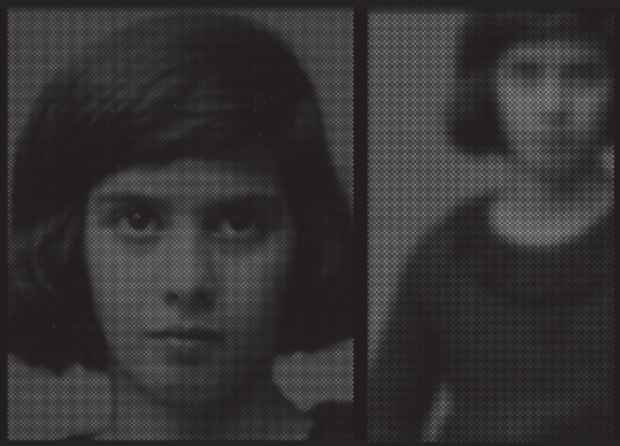Anne-Karin Furunes "Dialogue With Light"
Barry Friedman Ltd.

This event has ended.
Furunes creates haunting large-scale paintings of faces and land- scapes by perforating the surface of black or white canvas or unpaint- ed aluminum with thousands of di erently sized holes. The holes allow the image to coalesce for the viewer, similar to the halftone images in a newspaper. Her subtly pixelated images of particular people and sites reflect the artist’s concern with memory, history, and the nature of photographic reality. Furunes has exhibited her paintings extensively in Europe, and has created a series of monumental public works in Norway.
For this exhibition, the artist draws our attention to children who have lost their individuality and become targeted as a group be- cause of their collective religion, ethnicity, and more recently their political beliefs -- a tragic reoccurrence throughout history. To illustrate this, Furunes draws upon a photographic archive from Uppsala, Sweden from the 1910s and 1920s, focusing mainly on anonymous Jewish youth who were registered by the government because of their religion. Furunes chooses faces, which suggest the presence of a real personality, enigmatic and ungraspable. Rather than explicitly conveying emotion, these faces draw us in, making a connection beyond language and identity. Furunes often crops the images tightly, bringing the viewer into an intimate relationship with each face.
Furunes explains, “To see youngsters as a target, represents broken stories, taking away their future and potential. I am concentrat- ing on pictures of young people whom I find very vulnerable in our societies... When you look at these pictures, what strikes one is the serious maturity that they express. Today it seems that not even adults possess this kind of reflective awareness of the pre- cariousness of life. We are all trying to forget it. When viewing the archive images, the seriousness and the searching looks make a great impact on me. There seems to be a consciousness of uncertain times or the future in their eyes. These young people did not know what was awaiting them, but neither do today’s youth. There are bad and threatening signs in the air, but nobody really knows or seems to understand where we are heading. In a way, it is easy to identify with their feelings, even though we live in totally di erent times with other kinds of threats.”
Randi Nygaard Luim, Director of the Trondheim Art Museum writes, “It is the fate of ordinary, anonymous individuals that interests her: those who su er injury without society noticing – or caring. A beautiful birch tree has a surreal air to it as it stands before the prison barracks in a former concentration camp at Falstad, where terrible things happened during World War II. Nature may over- take history, but the underlying sinister atmosphere remains – the history and the episodes from which people cannot escape. It is in the photographic archives that these events are documented, and the fate of the anonymous victims.”
In her past work, Furunes has pursued the notion of historical recovery with images ranging from women who fought in the Finn- ish civil war of 1918, to Norwegian Jews who were deported by the Nazis at the start of World War II, to women and young girls in Sweden who were sterilized after being deemed undesirable due to their ethnicity, race, or intelligence; to the very young German soldiers sent to occupy Norway at the war’s end, to the visages of contemporary people, giving the viewer a chance to see their peers in a new and poetic context.
There is embodied in this work the historical implication of those who have been forgotten or purposely “disappeared” from public consciousness returning into view. Furunes has chosen subjects whose story has been denied a hearing, and thus restores their dignity and serves as a kind of public memory reasserting itself in the present.
Finally, in Furunes’ painting there is a meditative aesthetic which prompts the viewer to slow down and attend to the workings of one’s own consciousness, to our capacity for constructing visual illusion, and to the emptiness of real space pervading the solidity of what we regard as real.
Media
Schedule
from November 17, 2011 to January 14, 2012
Opening Reception on 2011-11-17 from 18:00 to 20:00